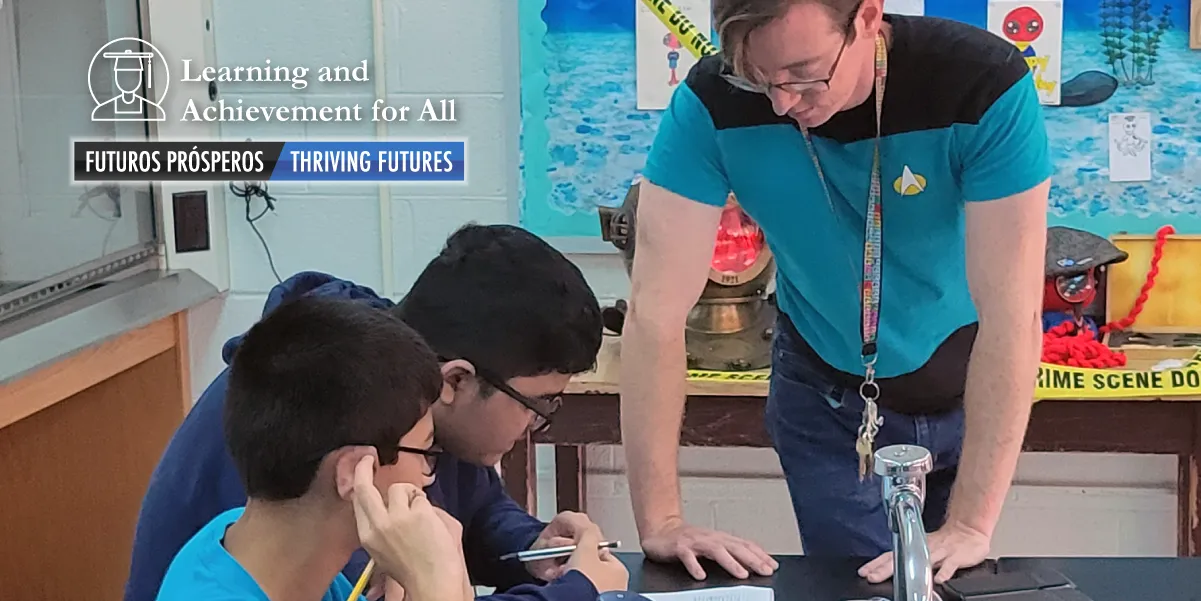
Fred M. Lynn Middle School students in the International Baccalaureate Middle Years Programme eighth grade physical science class sleuthed to find the thief responsible for a missing necklace. Students were briefed on the case, learning that a millionaire heiress lost her beloved antique pearl necklace. A mysterious white powder was left behind on the jewelry case. Four suspects were quickly identified, each represented by a Fred Lynn Middle teacher who dressed up and acted like the suspect to plead their case of why they were innocent.
“After hearing their cases, the students hypothesize who they think is responsible for the jewelry theft, but we stress that there simply isn't enough information to put any one of them in jail for the crime. That's where science comes in. The students must use physical properties such as touch, texture, and solubility in water, as well as chemical properties such as pH, reactivity with vinegar, and reactivity with iodine, to catch the criminal. The suspect that works with the powder that has the same properties as the mystery powder left behind on the box must be the criminal,” explained Scott Markley, eighth grade physical science teacher at the school.
The four suspects were all employees of the millionaire heiress, known to be unhappy in their work conditions.
- Suspect 1 – Farmer Bob uses cornstarch.
- Suspect 2 – Personal Chef Joe uses baking powder.
- Suspect 3 – Scientist Mario uses baking soda.
- Suspect 4 – Nanny Jan uses flour.
To find which of the four suspects above is responsible for the crime, the students used pipettes with different liquids, such as cabbage juice, iodine, vinegar, and water to test the chemical reactions of the four powders. In addition, the students used pH strips to test the white powders to determine if it was acid, base, or neutral. Together, the students drew conclusions to solve the crime by studying the physical and chemical properties.
“At the end, students must write a paragraph to the judge presenting their findings and arguing their case,” shared Markley, “in this case, the scientist Mario was responsible for stealing the necklace.”
Oliver Rabanales Lopez, eighth grade student, reached the right conclusion, stating, “Dear Judge: From my research on the case, I have concluded that the scientist Mario is responsible for stealing the jewelry. First, both the powder left behind and the baking soda he works with are neutral on the pH scale. Second, both powders fizzed when they reacted with vinegar. Third, both were absorbed by water, and have the same physical properties. Lastly, neither has a starch present. So, Judge, this is why Mario is the culprit.”
Los estudiantes de la Escuela Intermedia Fred M. Lynn resuelven el crimen del collar desaparecido con conocimientos básicos de química
Los estudiantes de la escuela intermedia Fred M. Lynn, en la clase de Ciencias Físicas de octavo grado del Programa de Bachillerato Internacional para los Años Intermedios, hicieron una investigación para encontrar al responsable de la desaparición de un collar. Los estudiantes fueron informados sobre el caso, al enterarse que una millonaria heredera perdió su amado collar de perlas antiguas. En el joyero había un misterioso polvo blanco. Rápidamente se identificaron cuatro sospechosos, cada uno de ellos representado por un profesor de la Escuela Secundaria Fred Lynn quien se disfrazó y actuó como el sospechoso para argumentar por qué era inocente.
"Después de escuchar sus argumentos, los estudiantes formularon una hipótesis sobre quién creían que era el responsable del robo de las joyas, pero les insistimos en el hecho de que, sencillamente, no hay suficiente información para acusar a alguno de ellos por el crimen. Es ahí donde entra en juego la ciencia. Los estudiantes deben utilizar propiedades físicas como el tacto, la textura y la solubilidad en agua, así como propiedades químicas como el pH, la reactividad con el vinagre y la reactividad con el yodo, para atrapar al criminal. El sospechoso que trabaje con el polvo que tiene las mismas propiedades que el polvo misterioso que se dejó en la caja debe ser el criminal", explicó Scott Markley, profesor de Ciencias Físicas de octavo curso del colegio.
- Sospechoso 1 - El granjero Bob utiliza maicena.
- Sospechoso 2 - El chef personal Joe utiliza levadura en polvo.
- Sospechoso 3 - El científico Mario utiliza bicarbonato de sodio.
- Sospechoso 4 - La niñera Jan utiliza harina.
Para averiguar cuál de los cuatro sospechosos anteriores es el responsable del delito, los estudiantes utilizaron pipetas con diferentes líquidos, como zumo de col, yodo, vinagre y agua, para comprobar las reacciones químicas de los cuatro polvos. Además, los estudiantes utilizaron pruebas de pH para determinar si los compuestos eran ácidos, alcalinos o neutros. Entre todos, los estudiantes sacaron conclusiones para resolver el crimen estudiando las propiedades físicas y químicas.
"Al final, los estudiantes deben escribir un párrafo al juez presentando sus hallazgos y argumentando su caso", comentó Markley, "en este caso, el científico Mario fue el responsable del robo del collar".
Oliver Rabanales López, estudiante de octavo curso, llegó a la conclusión correcta: "Estimado juez: A partir de mi investigación sobre el caso, he llegado a la conclusión de que el científico Mario es el responsable del robo de las joyas. En primer lugar, tanto el polvo que dejó como el bicarbonato de sodio con el que trabaja son neutros en la escala de pH. Segundo, ambos elementos efervescían cuando reaccionaban con el vinagre. Tercero, ambos fueron absorbidos por el agua y tienen las mismas propiedades físicas. Por último, ninguno de los dos tiene almidón. Así que, juez, por esto Mario es el culpable".
